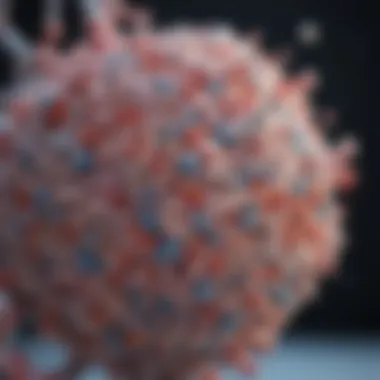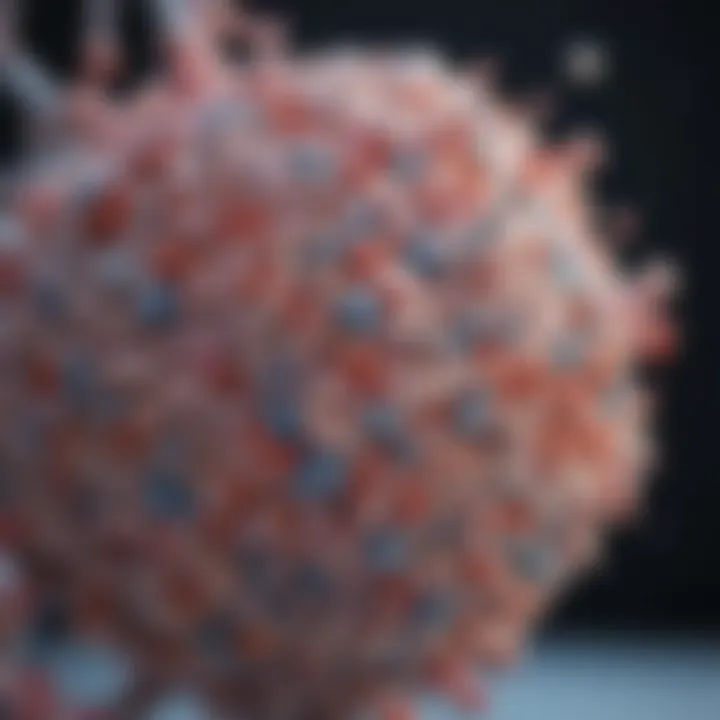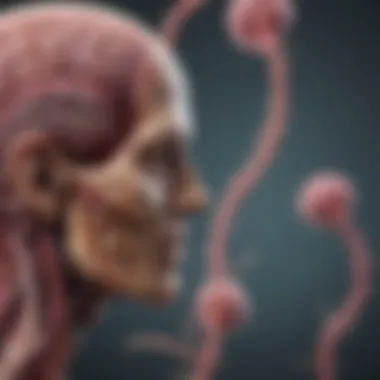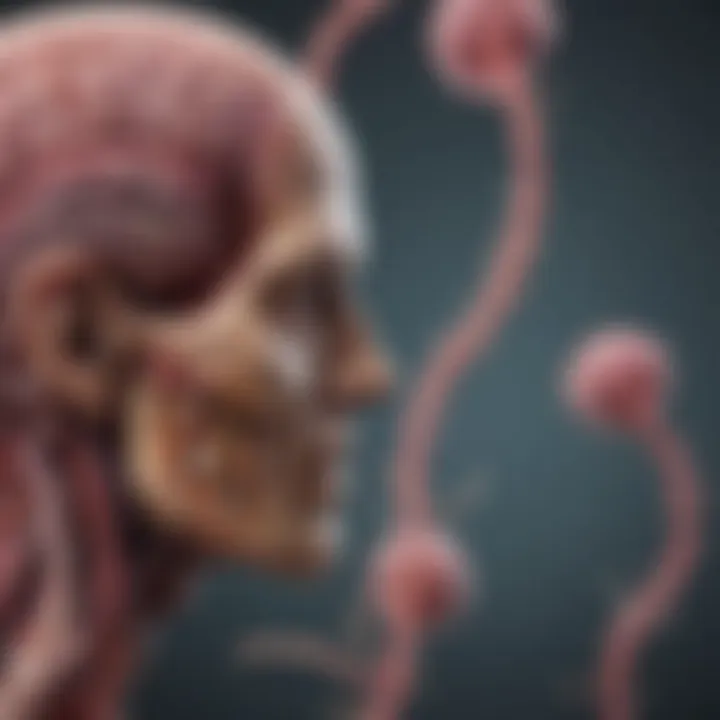BRAF Mutation in Glioblastoma: Treatment Insights


Intro
The landscape of glioblastoma treatment is often like navigating a dense forest—complex, challenging, and rife with dangers. At the heart of this battle against one of the most aggressive brain tumors lies a critical player: the BRAF mutation. Understanding this mutation isn't just an academic exercise; it has profound consequences for treatment methodologies and patient outcomes.
In recent years, research has shone a spotlight on the BRAF gene, which is responsible for producing a protein that plays a pivotal role in regulating cell division. When mutations occur in BRAF, they can lead to unchecked cellular growth—a hallmark of cancers like glioblastoma. This article delves into the nuances of BRAF mutations and their implications, not just in terms of pathology but also regarding modern treatment options.
Research Overview
Summary of Key Findings
Research indicates that BRAF mutations are present in a subset of glioblastomas, impacting disease prognosis and treatment approaches. Recent studies have illustrated that these mutations can influence the cancer's response to therapy, opening up avenues for targeted treatments that may enhance patient survival rates. The evolution of this field underscores a growing recognition of the BRAF mutation's role in glioma pathogenesis.
Background and Context
Glioblastoma multiforme, often described as a relentless foe in oncology, poses significant treatment challenges due to its aggressive nature and heterogeneity. Historically, treatment regimens have relied on surgical intervention, radiation, and conventional chemotherapeutics. However, the advent of molecular biology has transformed our understanding of cancer biology, illuminating how specific genetic alterations can dictate not only tumor behavior but also treatment responses.
BRAF's association with other cancers, particularly melanoma, has fueled research into its implications for glioblastoma. This relationship is neither simple nor straightforward—BRAF mutations may not only result in resistant tumors but also offer unique therapeutic opportunities when harnessed effectively.
As we unravel the complexities surrounding BRAF mutations, it becomes imperative to recognize their potential in reshaping the approach to glioblastoma management.
"Understanding the genetic landscape of glioblastoma not only offers insights into its pathogenesis but also lays the groundwork for innovative treatment strategies that could redefine patient care."
The need for ongoing research cannot be overstated, as both treatment paradigms and patient prognoses are at stake. The diagnostic methodologies currently employed must evolve alongside our understanding of these mutations to maximize clinical outcomes.
Foreword to Glioblastoma
Glioblastoma, one of the most aggressive forms of brain cancer, has garnered significant attention in both medical and research communities. This cancer type is notorious for its poor prognosis and complex biology, presenting numerous obstacles for effective treatment. Understanding glioblastoma is crucial, particularly as newer therapeutic avenues develop, especially concerning genetic factors like BRAF mutations.
Importance of Understanding Glioblastoma
The examination of glioblastoma must be comprehensive. It involves delving into its biological, epidemiological, and clinical facets. Not only does it shine a light on the devastating impact on patients and families, but it also opens a dialogue about innovative treatment strategies.
Benefits of Thorough Insight
Grasping the nuances behind glioblastoma can lead to:
- Better diagnostic techniques that help in early detection.
- Development of targeted therapies that hold promise over traditional methods.
- Improved understanding of how certain genetic alterations, like BRAF mutations, contribute to disease behavior.
Overall, knowledge about glioblastoma’s characteristics plays a vital role in optimizing patient care and guiding research directions. It establishes a foundation for more specific discussions about molecular interactions and therapeutic implications as we proceed in our exploration of BRAF mutations.
Challenges and Considerations
Despite advancements, challenges still plague glioblastoma treatment. High rates of recurrence, enhanced resistance to current therapies, and individual variations in treatment responses complicate clinical approaches. As such, understanding the overarching theme of glioblastoma sets the stage for evaluating BRAF mutations and their significant implications for both treatment and research.
Molecular Basis of Glioblastoma
Understanding the molecular basis behind glioblastoma is crucial for multiple reasons, especially when discussing targeted treatments. This knowledge allows researchers and medical professionals to develop more precise therapies, which is essential given the aggressive nature of this brain tumor. By recognizing the specific genetic alterations and pathways involved, treatment strategies likewise can be tailored to individual patients, potentially improving outcomes significantly.
Genetic Alterations
Genetic alterations act as the backbone of glioblastoma’s complex biology. Many of these changes can initiate tumorigenesis and drive tumor progression. For instance, mutations in TP53 and EGFR are recurrent in glioblastoma. The BRAF gene, especially, has gained attention due to its role in a subset of glioblastoma where its mutations can activate signaling pathways that promote cell division and survival.
Several genetic testing methodologies, such as next-generation sequencing, are being utilized to identify these mutations. By leveraging these tools, clinicians can not only diagnose glioblastoma but also categorize its variants effectively. Researchers continue to clarify the prevalence of various mutations; for example, while BRAF alterations are more common in certain grades of gliomas, their exact incidence in glioblastoma requires ongoing investigation. The accumulation of these genetic changes leads to a mosaic of aberrant signaling that fuels tumor growth further, making the study of genetic alterations essential in comprehending glioblastoma.
Role of Oncogenes and Tumor Suppressors
The interplay between oncogenes and tumor suppressors is particularly pivotal in glioblastoma. Oncogenes like BRAF act as accelerators of cellular division, while tumor suppressors like TP53 are meant to apply brakes on this process to prevent uncontrolled growth. When mutations arise in these genes, the balance can shift toward malignancy.
BRAF mutations, including the common BRAF V600E, lead to constitutive signaling through the MAPK/ERK pathway, advocating for growth and survival at the expense of normal cellular control. Conversely, the loss of function in tumor suppressors such as PTEN compromises cellular integrity, allowing for aberrant pathways to flourish. This dance between the oncogenes and tumor suppressors creates an environment ripe for glioblastoma's aggressive behavior.
Understanding these mechanisms not only enhances our perspective on glioblastoma's pathogenesis but also highlights potential targets for intervention.
As research continues to unfold, the recognition of other contributing factors—including epigenetic changes—adds layers to the understanding of glioblastoma. Ongoing studies are necessary for unveiling how these alterations work together in glioblastoma’s development. In sum, the molecular landscape of glioblastoma anchoring our approach to treatment and research is intricate and ever-evolving, making it a vital part of any comprehensive dialogue on this formidable disease.
The BRAF Gene: An Overview
Understanding the BRAF gene is a pivotal part of deciphering the landscape of glioblastoma, given its vital role in tumor development and progression. BRAF, a serine/threonine kinase, is involved in the MAPK pathway, which orchestrates cell division, differentiation, and survival. By exploring the nuances of this gene, researchers can unveil critical mechanisms that influence therapeutic responses and patient outcomes in glioblastoma cases.
Structure and Function of BRAF


The BRAF gene is located on chromosome 7 and encodes a protein that plays a crucial role in the RAS/RAF/MEK/ERK signaling pathway. This signaling cascade is responsible for transmitting signals within cells, facilitating processes such as proliferation and survival. BRAF functions as a downstream effector of RAS, a well-known oncogene. Activating mutations in BRAF can lead to persistent signaling, akin to leaving a light switch on, which causes unregulated cell growth and contributes to tumorgenesis.
To break it down further, BRAF consists of various domains, each with distinct roles:
- N-terminal regulatory domain: This domain acts as a gatekeeper, controlling the activity of the kinase.
- Kinase domain: The heart of its function, where phosphate groups are transferred to downstream proteins, thus activating them.
- C-terminal domain: This region can influence BRAF's stability and interaction with other proteins.
Understanding this structure is paramount. Aberrations within it can lead to non-stop signaling, resulting in unchecked cell proliferation that typifies glioblastoma.
Types of BRAF Mutations
BRAF mutations are an interesting aspect to consider. The most prevalent mutation found in tumors is BRAF V600E, which results from a single nucleotide change in the DNA sequence. This type of mutation leads BRAF to adopt a constitutively active form, meaning it functions all the time, pushing cells toward growth and survival regardless of the normal regulatory mechanisms.
However, BRAF isn’t limited to just the V600E variant:
- V600K: Similar to V600E, but may exhibit slightly different biochemical properties and response to treatments.
- D594 mutations: Less common, yet demonstrated to activate the kinase in distinct pathways, possibly leading to different therapeutic responses.
These mutations serve as not just markers of disease but also potential targets for treatments. Studies indicate that BRAF-targeted therapies could hold promise for certain patients, but the variability among mutations underscores the necessity for personalized treatment strategies. Through understanding the specific nature of the mutation, healthcare providers can tailor interventions that have a higher likelihood of success.
“The understanding of BRAF mutations extends beyond mere classification; it presents an opportunity to tailor more effective strategies in the treatment of glioblastoma.”
In summary, knowledge surrounding the BRAF gene, including its structure and the specific types of mutations, is a cornerstone in shaping the approach to glioblastoma treatment and research. As this field continues to evolve, the insights gained from BRAF exploration are likely to pave the way for significant advancements in patient care.
BRAF Mutations in Glioblastoma
BRAF mutations represent a significant aspect of glioblastoma, a tumor known for its aggressive nature. Glioblastoma affects the brain and spinal cord, presenting a formidable challenge for both diagnosis and treatment. An in-depth understanding of BRAF mutations furthers our insight into the molecular landscape of this cancer, allowing for tailored treatment approaches that can improve patient outcomes.
The main concern around BRAF mutations is their implication on various aspects of glioblastoma, including prevalence, detection methods, and mechanisms of action. In recent years, research has underscored the need for precise detection methods, which can guide effective treatment decisions.
Moreover, BRAF mutations present opportunities for creating targeted therapies aimed at specific molecular pathways. This may ultimately provide hope for better management strategies that can prolong survival rates and improve quality of life.
Prevalence and Detection
Knowing how frequently BRAF mutations occur in glioblastoma is crucial for understanding their role in this disease. Research indicates that they are present in a small but significant percentage of glioblastomas—estimates suggest around 5-10% in adult cases. This varying prevalence can often be attributed to factors like patient age and the specific tumor characteristics.
Detecting these mutations is often achieved through advanced techniques such as:
- Next-generation sequencing (NGS): This method allows for a comprehensive analysis of the genome, making it easier to identify specific mutations.
- Polymerase chain reaction (PCR): A sensitive technique that amplifies DNA fragments to pinpoint mutations with precision.
- Immunohistochemistry: This technique helps in visualizing abnormal protein expression that might signal BRAF mutations.
Early detection plays a key role in treatment success. If identified early, doctors can employ targeted therapies that could significantly affect the patient’s treatment journey.
Mechanisms of Action
BRAF mutations alter the behavior of signaling pathways, impacting how glioblastoma cells grow and spread. The most common mutation, known as BRAF V600E, leads to uncontrolled cell division due to the activation of the MAPK/ERK signaling pathway. This pathway is crucial for cell proliferation and survival, and its dysregulation becomes a double-edged sword—it allows tumor cells to thrive and resist conventional treatments.
Understanding these mechanisms enables researchers and clinicians to explore effective therapeutic strategies. Some specific actions include:
- Inhibition of BRAF: Targeted BRAF inhibitors, such as vemurafenib, are designed to block the function of the mutated protein, hindering tumor growth.
- Combination therapies: Using BRAF inhibitors in conjunction with other targeted agents or immunotherapies can create a more robust attack on glioblastoma cells.
This multifaceted approach underscores the importance of continuing research in this area. Identifying new molecular targets and understanding how they interact with BRAF mutations is essential for advancing treatment modalities.
Ultimately, tackling BRAF mutations in glioblastoma may unlock new avenues in cancer treatment, contributing to better patient experiences and outcomes.
Impact of BRAF Mutations on Glioblastoma Prognosis
The province of glioblastoma research is vibrant, yet daunting. Among the multitude of genetic alterations observed in glioblastoma, BRAF mutations stand out as a significant focus. This section delves into the implications of these mutations on prognosis, underscoring their clinical relevance and the intricate web of influences they interlace with other biological factors.
BRAF mutations play a pivotal role in determining the trajectory of treatment and patient outcomes. Understanding these implications isn't merely an academic exercise; it has real-world ramifications for patients and healthcare providers alike. Here, we explore how these mutations affect survival rates, how they interact with the broader genetic landscape of glioblastoma, and what this all means for future treatment strategies.
Survival Rates and Outcomes
Survival statistics for glioblastoma patients have long painted a grim picture—typically, most don't survive beyond 15 months post-diagnosis. However, those bearing specific BRAF mutations may experience a different reality. Data suggest that BRAF V600E mutations, in particular, can drastically influence survival rates.
Several studies have indicated that glioblastoma patients with BRAF V600E mutations tend to have distinct outcomes when compared to their wild-type counterparts. For instance, a cohort that includes BRAF mutation carriers may show a longer progression-free survival relative to those without this alteration, indicating a potential target for tailored therapies.
- Research Findings:
- BRAF V600E Mutation: Associated with more favorable survival in some studies.
- BRAF Non-V600E Mutations: Present a more complex picture, often linked to aggressive tumor behavior.
Thus, grasping the nuances of BRAF mutations allows oncologists to refine their prognostic models and tailor their treatment plans. The implications for patients could be profound, leading to increased clarity on expected outcomes and personalized treatment paths.
Correlation with Other Genetic Changes


In the vast landscape of glioblastoma genetics, BRAF mutations seldom operate in isolation. Instead, they often coexist with a plethora of other alterations, painting a comprehensive picture of each tumor's unique biology. For example, the presence of BRAF mutations has been observed alongside ID mutations, which could modify treatment response.
Moreover, research has shown that glioblastoma patients presenting dual mutations, such as both BRAF and P53 alteration, may face more daunting prognoses. Here's what the interconnections look like:
- Common Co-Mutations:
- TP53: Often present in conjunction with BRAF mutations.
- EGFR: High frequency in glioblastoma, sometimes intersecting with BRAF alterations.
This interplay among various genetic changes indicates the complexity of targeting therapies. The heightened level of interactions calls for a broader perspective when formulating treatment protocols. Considering these co-existing mutations aids physicians in selecting therapies, be it targeted or conventional, and in preparing patients for their unique prognostic scenarios.
"Understanding the genetic interplay in glioblastoma not only elucidates patient outcomes but can also shape therapy development pathways."
The pursuit to decode the effects of BRAF mutations on prognosis reiterates the need for nuanced genetic testing and personalized medicine in the realm of glioblastoma research. As the field progresses, continued exploration of these genetic intricacies promises to unveil new therapeutic prospects and enhanced outcomes for patients.
Current Treatment Strategies
In the context of glioblastoma, addressing BRAF mutations is pivotal to improving patient outcomes. This section covers the contemporary treatment strategies employed to tackle glioblastoma, particularly focusing on the adaptations necessitated by the presence of BRAF mutations. With the aggressive nature of this cancer, understanding these treatment approaches not only holds therapeutic potential but also alters the landscape of clinical management.
Conventional Approaches
Conventional treatment modalities for glioblastoma primarily involve surgical intervention, radiation therapy, and chemotherapy. The standard course often begins with surgical resection when feasible, aimed at removing as much of the tumor as possible. However, glioblastomas tend to infiltrate surrounding brain tissue, making complete resection challenging.
Chemotherapy, commonly involving temozolomide, is administered post-surgery. This drug's efficacy is somewhat limited, particularly in patients with BRAF mutations, as the mutation can lead to more aggressive tumor behavior and resistance to conventional agents. Radiotherapy complements surgical efforts and chemotherapy; yet, the response is variable and often diminishes over time due to tumor recurrence.
"While traditional treatments lay the foundation, they often fall short in the face of biological complexities associated with these mutations."
Thus, while these conventional approaches are essential, their limitations underscore the need for additional or alternative strategies to enhance effectiveness.
Targeted Therapies
The emergence of targeted therapies marks a significant advancement in treating BRAF-mutated glioblastoma. These therapies exploit specific molecular characteristics of the tumor cells, aiming to inhibit the aberrant signaling pathways activated by BRAF mutations.
For instance, BRAF inhibitors such as vemurafenib have shown promise in certain cases. They selectively target BRAF V600E mutations, leading to reduced tumor growth in some patients. However, these treatments often face challenges, including the development of resistance, which can occur as the tumor adapts to the selective pressure of therapy. Furthermore, not all BRAF mutations fall into the same category, complicating the therapeutic landscape even further.
- What are the key challenges?
- Mutational heterogeneity can alter therapeutic response.
- Resistance mechanisms can activate alternative pathways.
The bottom line is that while targeted therapies hold significant potential, their implementation requires a nuanced understanding of each patient's unique tumor profile.
Immunotherapy Developments
The role of immunotherapy in glioblastoma is an expanding frontier. In recent years, the advent of checkpoint inhibitors has sparked significant interest. These agents work by unleashing the immune system from its regulatory controls, thereby enabling it to recognize and attack tumor cells more effectively.
Preliminary studies suggest that certain patients with BRAF mutations may respond favorably to these therapies, particularly when combined with other strategies. Combination treatments, where immunotherapy is used alongside targeted therapies or conventional methods, are under active investigation to enhance responses and address resistance mechanisms.
- Innovations in Immunotherapy:
- Personalized vaccine development tailored for BRAF mutations.
- Adoptive T cell transfer targeting tumor-specific antigens.
The potential success of immunotherapy mounts a significant challenge to traditional models of treatment, positioning it as a cornerstone of future glioblastoma management, especially for those with high mutational burdens like BRAF.
Emerging Therapeutic Approaches
Emerging therapeutic approaches play a crucial role in the ongoing battle against glioblastoma, especially with BRAF mutations putting a significant twist on treatment options. As glioblastoma remains a formidable adversary in oncology, the effective targeting of these specific mutations can lead to improved outcomes and a better quality of life for patients. This section will delve into various innovative strategies that are being explored to enhance the efficacy of glioblastoma treatment.
BRAF Inhibitors: Current State and Future Directions
BRAF inhibitors have emerged as a beacon of hope for patients with BRAF-mutated glioblastoma. The promise they hold is in their ability to specifically target aberrant BRAF proteins that drive tumorigenesis. At present, vemurafenib and dabrafenib are two notable BRAF inhibitors that have shown effectiveness in other cancers like melanoma. However, their application in glioblastoma is still under extensive study. Early-phase clinical trials have exhibited mixed results, often hinging on the specific mutation type and the tumor's genetic landscape.
One significant consideration is the challenge of the blood-brain barrier, which complicates the delivery of systemic therapy. Scientists are now investigating novel delivery systems, such as nanoparticles, to circumvent this limitation and improve drug concentration directlly within the tumor. Future research is likely to explore combinations of BRAF inhibitors with other therapeutic agents to build a robust treatment strategy.
"The journey toward effective treatment of BRAF-mutated glioblastoma is complex, but the potential for significant breakthroughs exists with ongoing research and innovation."
Combination Therapies
The application of combination therapies signifies a strategic shift in treating glioblastoma. Instead of relying solely on monotherapies, integrating various treatment modalities can enhance effectiveness and potentially overcome resistance mechanisms. For instance, pairing BRAF inhibitors with MEK inhibitors seeks to create a synergistic effect, targeting the same signaling pathway from different points. The idea is simple: if one road is blocked, the other might still lead to the destination.
Moreover, researchers are exploring combinations with immunotherapies. Given the unique immune environment of glioblastoma, integrating checkpoint inhibitors with targeted therapies could potentially enhance anti-tumor responses.
Key elements of combination therapies include:


- Customized Approaches: Treatment plans can be tailored to the unique genetic profile of each patient’s tumor.
- Differentiation in Treatment Response: By using multiple targets, it becomes harder for the tumor to escape treatment.
- Mitigating Side Effects: Lower doses of each therapy may result in fewer adverse effects while still being effective.
Ongoing research needs to focus on how these combinations can be optimized to avoid overlapping toxicities, which could deter patient compliance and overall success. Future clinical trials are essential to confirm the best approaches for combining therapies effectively.
The search for effective therapeutic strategies tailored for BRAF-mutated glioblastoma is still in its infancy. However, the prospects of BRAF inhibitors and combination therapies present thrilling opportunities to reshape the landscape of treatment for this challenging condition.
Challenges in Treating BRAF-Mutated Glioblastoma
Treating glioblastoma that carries BRAF mutations presents a unique set of challenges. These complexities highlight the difficulty in formulating effective treatment plans, which is crucial for improving patient outcomes. The adaptability of glioblastoma, particularly in the context of BRAF mutations, underscores the pressing need to navigate these challenges in an informed manner.
Resistance Mechanisms
One of the major hurdles in tackling BRAF-mutated glioblastoma is the emergence of resistance mechanisms. When patients initially respond to targeted therapies—such as BRAF inhibitors—many eventually experience treatment failure. This can occur through various avenues:
- Secondary Mutations: The glioblastoma cells may develop additional mutations that enable them to bypass the effects of BRAF inhibitors. For example, mutations in downstream signaling pathways can allow the cancer cells to continue proliferating despite the targeted treatment.
- Feedback Activation: The cells may also activate alternative signaling pathways in response to inhibitors, leading to sustained growth. This often means switching tactics mid-battle, which can be frustrating for both patients and clinicians.
These mechanisms reveal why continuous monitoring is essential for patients with BRAF mutations. Testing through techniques like liquid biopsies can provide updated insights into the genetic landscape of tumors over time. Resolving the issues related to resistance is not only pivotal for treatment efficacy but also for patient survival.
Patient Variability
Individual variability among patients with BRAF-mutated glioblastoma further complicates treatment. Not every patient is going to respond similarly to the same targeted therapies. Personal factors can include:
- Genetic Makeup: Unique genetic factors can influence a patient's response to treatments. Variations not just in BRAF but in other related pathways can signal differing vulnerabilities in cancer cells.
- Tumor Microenvironment: The surrounding tumor microenvironment plays a critical role in therapeutic response. For instance, the presence of immune cells, blood vessels, and the extracellular matrix can either facilitate or hinder the efficacy of treatments.
The recognition of this variability stresses the importance of personalized medicine. One-size-fits-all approaches may fall flat, which is why therapies need to be tailored to each patient’s specific genetic and molecular makeup.
In summary, tackling BRAF-mutated glioblastoma requires an understanding of the resistance mechanisms and the nuanced patient variability that complicates treatment strategies.
Addressing these challenges is integral to paving the way for more effective and adaptive treatment paradigms. Through relentless research and careful observation, the hope remains to outsmart this formidable adversary.
Future Directions in Research
The exploration of BRAF mutations in glioblastoma represents not only a journey into genetic intricacies but it also reveals paths rich with potential for treatment advancements. Understanding these mutations sheds light on the overall landscape of glioblastoma, paving the way for novel interventions and more personalized therapeutic strategies. In this section, we will delve into key aspects that could revolutionize our approach to this aggressive cancer, focusing on the promise that lies within next-generation sequencing applications and the development of biomarkers.
Next-Generation Sequencing Applications
Next-generation sequencing (NGS) has drastically altered the playing field in cancer genomics. In the context of glioblastoma, NGS allows for a comprehensive examination of tumor genetics, enabling researchers to identify specific BRAF mutations and additional co-occurring genetic alterations. This method not only expedites the detection of mutations but also assists in understanding their functional impact on tumor behavior.
The benefits of NGS in glioblastoma research are manifold:
- Precision Medicine: Identifying distinct genetic profiles can help tailor treatment regimens suited to individual patients. Each glioblastoma may not respond uniformly to therapies. Therefore, insights from NGS can lead to more effective, targeted therapies.
- Early Detection and Monitoring: By regularly analyzing tumor samples from patients via liquid biopsy approaches, doctors may observe changes in genetic profiles, providing a real-time understanding of disease progression.
- Research Advancements: The cumulative data gathered from large-scale genomic studies can open discussions about novel treatment paradigms and clinical trials focusing on BRAF mutations and their implications in glioblastoma.
Furthermore, ongoing improvements to NGS technology enhance its efficiency and reduce costs, making it a cornerstone for future glioblastoma research endeavors.
Biomarker Development
Biomarkers hold a significant promise in the realm of glioblastoma, particularly for those harboring BRAF mutations. These biological indicators can serve several essential roles, including aiding in diagnosis, predicting treatment responses, and assessing patient prognosis.
The development of biomarkers for BRAF mutations can lead to significant progress in the management of glioblastoma. Some crucial considerations include:
- Predictive Power: Discovering reliable biomarkers that correlate with BRAF mutation status can enhance screening processes. This predictive capability could potentially identify patients who would benefit from targeted therapies, mitigating the "one-size-fits-all" approach.
- Therapeutic Monitoring: Biomarkers can be valuable tools in evaluating the efficacy of BRAF inhibitors and other targeted treatments. By analyzing changes in biomarker levels, clinicians could gauge whether a treatment is working or if a change in strategy is necessary.
- Research Pathways: The establishment of a robust biomarker pipeline invites further investigations. It also aids in defining patient populations for clinical trials, ensuring that the right therapies are explored in the right patient cohorts.
In summary, the future of glioblastoma research, specifically focusing on BRAF mutations, lies in the dual avenues of next-generation sequencing and biomarker development. These tools not only enhance our understanding but also pose substantial prospects for more effective treatment interventions.
As researchers and clinicians continue to navigate the complexities of glioblastoma, it becomes increasingly clear that these emerging strategies hold the key to unlocking a more hopeful horizon for patients and caregivers alike.
Ending
In summarizing the implications of BRAF mutations within the landscape of glioblastoma, it becomes clear this topic stands at the intersection of precision medicine and neuro-oncology. The identification of BRAF mutations not only informs us about the biological behavior, but it also forges a pathway toward tailored treatment strategies. By dissecting the relationship between these genetic alterations and the tumor's response to therapies, we make strides into more effective management of glioblastoma.
Summary of Key Findings
The exploration of BRAF mutations has unearthed several critical insights:
- Prevalence: BRAF mutations, while not universally present, carry significant weight in certain glioblastoma cohorts. They can influence overall tumor progression and patient outcomes.
- Mechanism of Action: BRAF mutations activate downstream signaling pathways—like the MAPK pathway—essential for tumor growth and survival.
- Prognostic Value: The presence of BRAF mutations serves as a potential prognostic indicator, shaping not only survival rates but also the characteristic aggressiveness of the glioblastoma.
In essence, understanding the specifics around BRAF alterations provides a framework for developing not just hypothetical treatments, but actionable clinical strategies.
Importance of Continued Research
The field of glioblastoma research is ever-evolving, and the importance of ongoing investigation into BRAF mutations cannot be overstated.
- Evolving Technologies: As next-generation sequencing techniques become more accessible, the ability to identify and analyze specific mutations is improving, paving the way for personalized patient care.
- Combination Therapies: Research should incorporate BRAF inhibitors with existing therapies such as immunotherapy. This synergistic approach could reinforce treatment efficacy and counteract resistance mechanisms.
- Unraveling Complexity: Glioblastoma is a heterogeneous disease, and its interactions with mutations like those in BRAF require deeper exploration to fully understand treatment implications.
"In cancer research, every mutation tells a story; the challenge lies in deciphering this narrative to unlock new frontiers in treatment."
The future landscape of treatment for glioblastoma will heavily rely on insights gained from detailed studies of BRAF mutations and their role within the broader genomic context. As findings accumulate, they hold the potential to reshape therapeutic paradigms, driving forward the imperative for sustained inquiry in this critical area.







